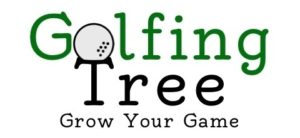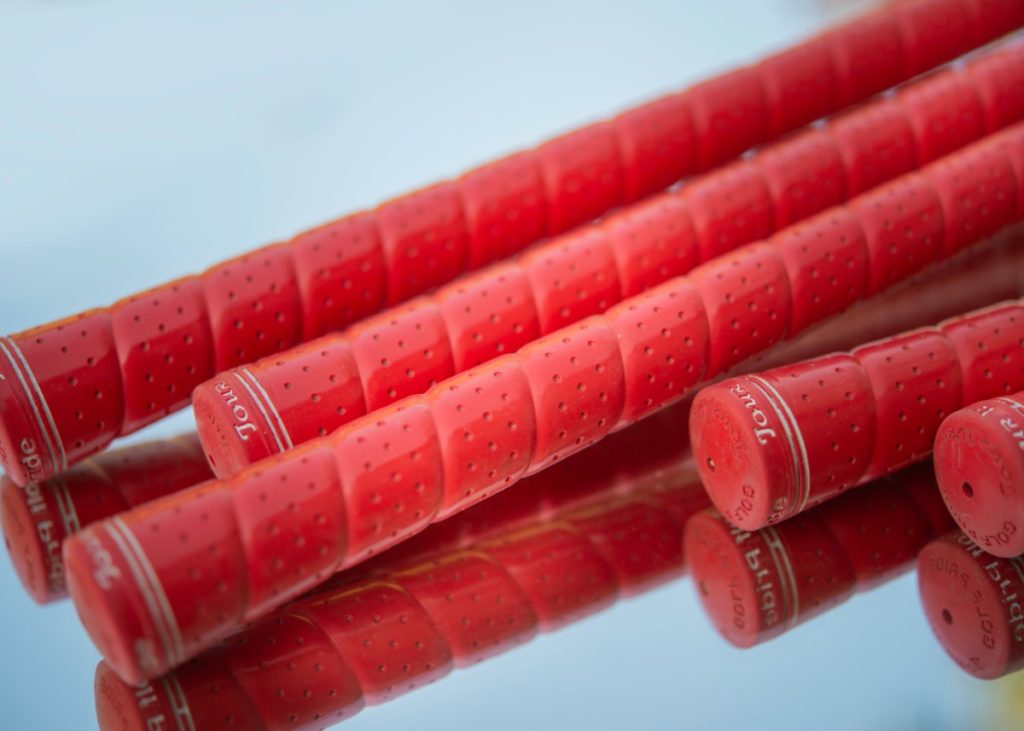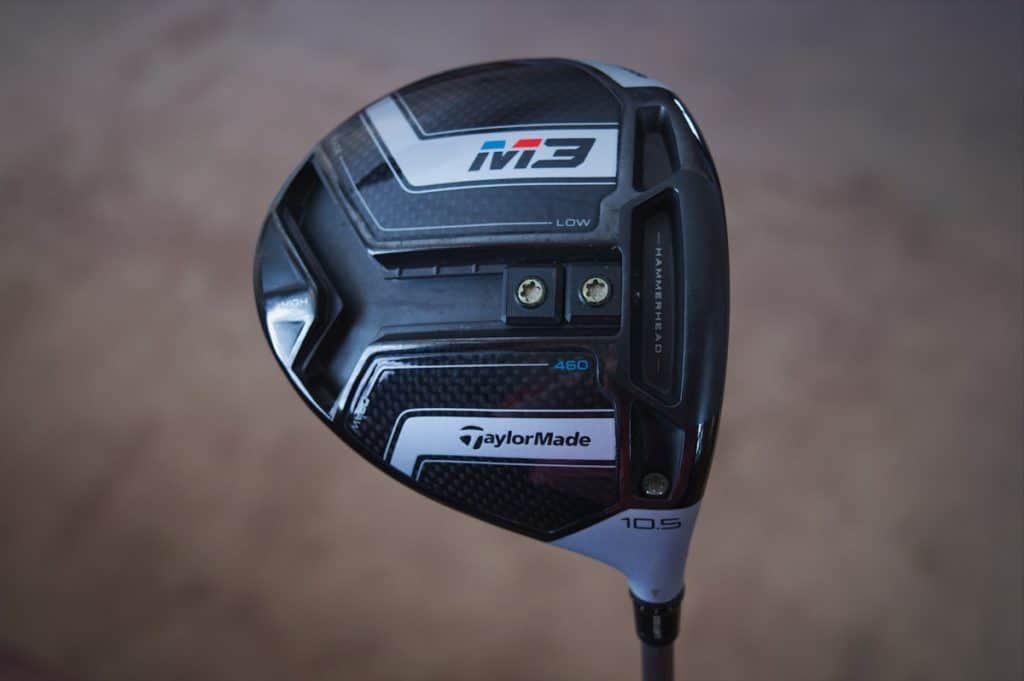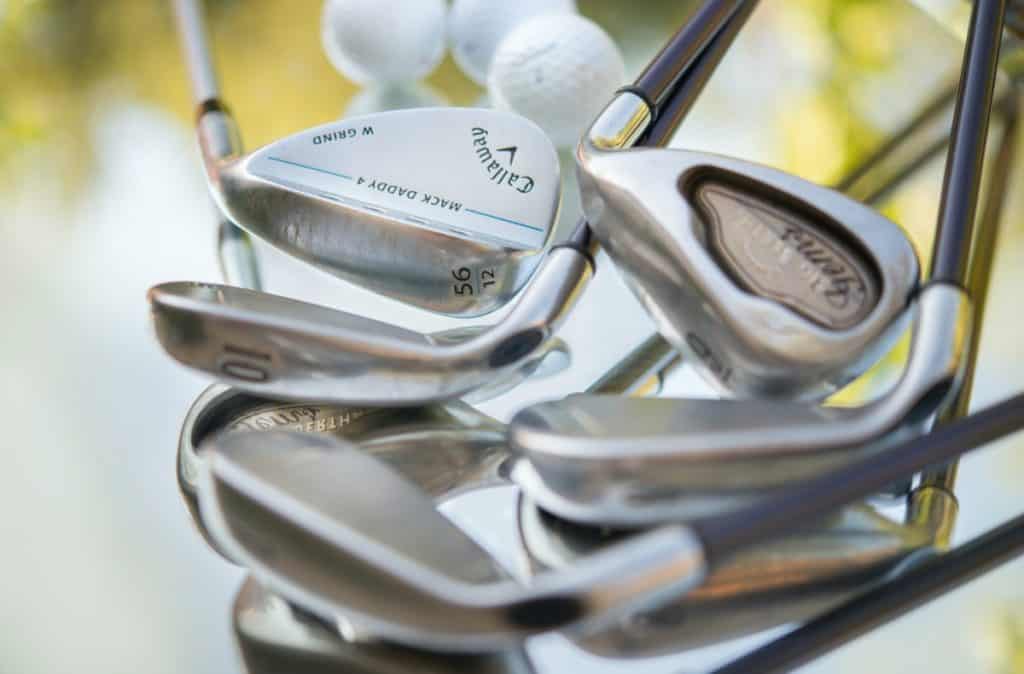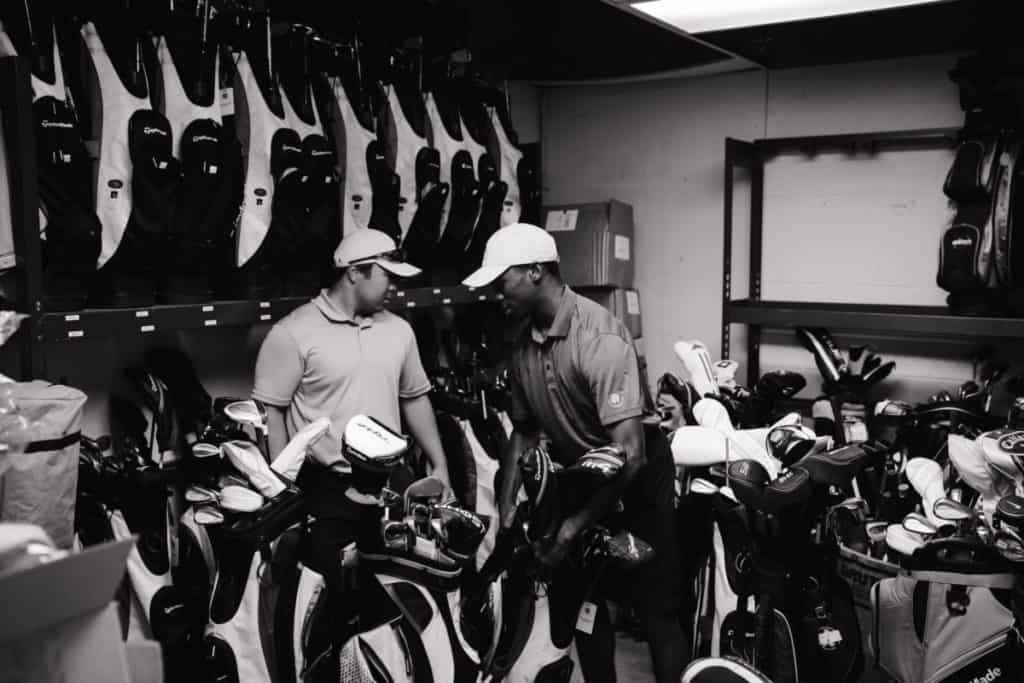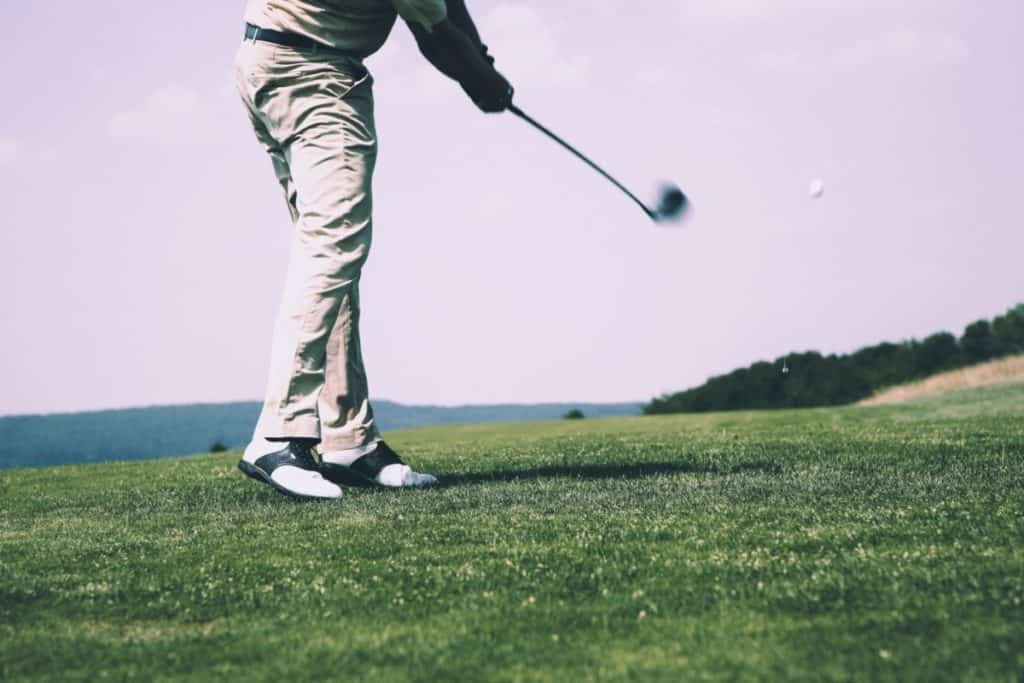
If you’re an avid golfer who also enjoys watching the pros on TV, there might have come to a point where you ended up wondering—how exactly do they hit the ball so much farther off the tee?
Questions surrounding a powerful long game have especially come into the spotlight after the 2020 US Open, with Bryson Dechambeau exhibiting a remarkable ability to drive the ball to a long distance. So, what are the reasons golf pros hit the ball so far?
Golf pros hit the ball so far due to a variety of factors. They maximize clubhead speed, make accurate contact with the ball while using their bodies with great efficiency during the swing. Additionally, data collection and analysis allows them to be coached with the greatest efficacy.
In the rest of this article, we will explore the different reasons golf pros can hit the ball at such a great distance.
For these factors, we must both look at in-the-moment practices of actually taking the swing as well as what the pros are doing off the course and in training. Additionally, we will look at some tips to improve your ability to hit the ball farther without sacrificing accuracy.
Maximized Clubhead Speed
When it comes to getting your ball to go long distances, the ability to increase your clubhead speed will bring more power to the impact you make with the ball. Clubhead speed is the measurable speed of your club at the moment before it strikes the ball.
Pros are typically hitting a driver with a clubhead speed of 120-130mph (193-209 kph) (and occasionally even faster), while amateurs are much more likely to come in around 100 mph (160 kph) or less.
What to Consider to Swing at a Faster Rate
So, what’s the difference? What do pros do differently in order to consistently swing at a much faster rate than the average weekend golfer?
Speed of the Backswing
One of the answers to this can be found in the backswing. As the name suggests, the backswing is when the golfer raises the club up behind him in the initial movement of his golf swing. When the club reaches the top of the swing, the backswing ends, and the downswing begins.
This is where physics comes in. It comes down to kinetic energy or the amount of energy that is created by motion. The more kinetic energy you can generate in your swing, the more you will be able to transfer to the ball and hit a farther distance.
The idea is to generate as much possible kinetic energy before making contact with the ball. This can be done in two different ways—either by increasing the average force or the length of the path your hands are traveling in the swing. To put it simply, speed up your backswing in order to bring more power to your downswing.
To see this put into action, you can check out this Youtube video where golf expert Dr. Sasha McKenzie helps a golfer speed up his backswing to make significant gains in clubhead speed:
Moment of Inertia and the Downswing
The next approach that pros take to increasing their clubhead speed has to do with the moment of inertia. This law of physics states that in order to rotate something, you will be able to perform this action better and more effectively depending on where the weight of the object is. The closer the weight of what you are trying to rotate is to the center, the easier it will be.
If you try to rotate something where the weight is much farther out, you will not be able to harness the speed and power as effectively. In golf, the center can be considered your body, and the weight of what you are rotating is the club.
You will see pros using this law of physics to their advantage in the downswing. As a pro golfer lifts the club into the backswing, it will be significantly farther away from his body than when he brings it into the downswing. By keeping this closer to his body, the golfer is able to keep the weight of the rotation closer to the center, thus increasing the clubhead speed.
On the follow-through, you will see the arms and the club coming much farther from the body, but this after the club has struck the ball. In those moments leading up to striking the ball, it is important to keep the downswing tight to maximize clubhead speed potential.
How to Increase Clubhead Speed at Home
In order to put this into practice, you can try taking the ball out of the picture and removing the need to make contact with anything at first. Take your club and loosen up your body, preparing to practice without a golf ball.
At first, simply practice the swinging motion, paying attention to how your body moves through this motion. Feel how you can manipulate where the club’s weight is in relation to your body at different moments in your swing. Notice the distance from your body in your backswing as opposed to your downswing. Then, notice again where the club goes in your follow-through.
Right now, the idea is to get used to how the swing feels and build some muscle memory around that. Sometimes the motivation to hit the ball can take the golfer away from how the swing is feeling in his body. Slowly, as you become ready to incorporate further challenges, add a tee so you can practice making contact with something without the added pressure of hitting a ball accurately.
When you add the ball back into the mix, see if you are still able to move through your swing in the same way you could without the ball. Is your body still moving in an efficient way, making use of physics to maximize your clubhead speed? Or, are you becoming distracted by the goal of hitting the ball and losing form? Be sure to observe yourself and practice with and without the ball as necessary.
Accurate Point of Contact
Pro golfers are not just powerful hitters, but they are accurate when it comes to how their clubhead and the ball meet. They have acquired the skill of aligning themselves with the ball in a way that allows them to make contact accurately and send the ball where they want it to go.
If you were to compare two golfers who are hitting with identical clubhead speeds but one of them was able to make more direct contact with the sweet spot between the driver and the ball, that player would be able to hit the ball farther. Not only would the ball go farther, but it would also go in a more accurate way.
In order to achieve an accurate point of contact, you will need to hit it squarely with the clubhead. When striking with your driver, you should be hitting the ball right in the center of the driver’s face. If you find that you are too often making contact on the heel of the driver’s head, try adjusting your positioning back a bit to make more accurate contact.
Smash Factor
In order to measure the accuracy of the point of contact with the ball, pro golfers use a key metric known as the smash factor. This is the speed of the ball divided by the speed of the clubhead. The more accurately the ball was struck will translate to a higher smash factor. When using a driver, golfers are looking for this number to be around 1.5.
This helps assess what happens after the clubhead hits the ball. If the clubhead speed was high, but the ball did not go as far as expected, it means that the energy transfer between the two was not optimum. The smash factor is lower without optimal energy transfer, meaning that the ball speed will be lower. This means that the ball will not travel as far as it could have with a more accurate strike.
If you’re interested in improving your accuracy, you can take some spray foot powder and lightly coat the face of your driver. As you hit the ball, the powder will come off where the ball made contact with the driver. This is a simple visual way for you to become more aware of where you are hitting the ball on the face of your club.
Swinging With Ease and Efficiency
There is an intricate combination of body movements that occur when swinging a golf club. Typically, pros have an incredibly efficient way of coordinating their bodies to bring the clubhead in fast and strong. This involves their core, arms, legs, and various muscles throughout their whole body.
Pros have practiced this coordination extensively and under the watch of insightful and trained teachers. They have managed to get the sequence of events timed so perfectly that they are able to get the club where it needs to go with speed and power.
However, amateurs will likely have some inefficiencies in their body movement that hasn’t been trained out of them. Without the drilling and coaching that pros get to refine their form, amateurs may be moving the club in a not maximally efficient way.
These inefficiencies may manifest in different ways with different golfers. If you are truly curious where your weak spots are in your swing, taking some one-on-one training sessions with a golf teacher would be a great way to understand your own specific needs. Many golf clubs will also offer weekend seminars and other workshops where you can get some in-person advice and supervised practice to improve your game.
However, let’s take a look at some common mistakes amateurs make in their body movement. These are mistakes you won’t see in the pros, and recognizing them here can be your first step in improving these inefficiencies for yourself.
The Importance of Staying Close to the Ground
One specific way of thinking about this efficient body movement is how the pro golfers move their bodies in relationship to the ground. We can use the head position as a way to judge how the body is engaged in movement during the backswing and the downswing.
Think about your own swing for a moment—does your head usually stay in one position throughout your swing? Do you feel it moving slightly down? Or, perhaps slightly up?
Let’s turn now to the pros and their head position through the backswing and downswing. Typically, when you see pros who are very efficient strikers, you will see that their head maintains its general position or moves just slightly down.
However, if there is movement, it is not much, and any movement should be directed towards the ground. Why is this important to notice, you might wonder. How does their head position translate into greater efficiency?
To summarize for the backswing, by keeping the head mostly still, it means you are maintaining your position and distance over the golf ball. This is key as we move into the next phase of the swing or the downswing.
During the downswing, or as the club comes down to hit the ball, you will see the professionals bringing their body slightly lower, coming just slightly closer to the ball sitting on the tee. This will continue until they make contact with the ball. Once the ball has been hit, it is at this point only that you will see the pros come up and straighten their bodies more upright.
Advantages of Staying Close to the Ground
There are several reasons why staying low through the backswing and downswing is advantageous. Staying close to the ground forces the player to keep a bend in the arms and wrists. By not allowing too much comfortable distance here, it is impossible to straighten out the arms too much, as some amateurs tend to do. Being close to the ground forces the bend that creates a better technique for striking the ball.
Another motion that becomes necessary when staying close to the ground is the turn at the end of the downswing. If you are too vertical, you will not be forced to turn your body as you follow through with your swing. If you are maintaining a position close to the ground, you will have to turn as you come up.
How to Swing With Ease and Efficiency
To summarize, being aware of your body position and maintaining the right distance to the ground will help the other pieces of the swing fall into place naturally. It will keep the right joints bent and support the proper motions needed for an effective swing.
Stay close to the ground. Do not give yourself too much room to straighten out your arms or wrists. By paying attention to the distance between the ball and your body, you will be able to mimic the stances of elite ball strikers.
So, how can this be achieved? The first part of the body that will help you get lower to the ground and more striking power is in the knees. You do not want to be standing straight, with legs locked. You want your knees to be generously bent to get you closer to the ground.
The next part of your body that can help you is your hip region. By making sure you are tilting forward a bit at the hips, you will be able to get the upper body angle you need. Your hips will also tilt as you twist your body into the backswing and in the follow-through.
The last thing to remember is to keep these body parts engaged through the entire swing. As you rise up into your backswing and as you move into your downswing, let these joints help you stay low to the ball.
If you are interested to see this in action, you can check out Eric Cogorno’s video on Youtube:
Using Technology to Gather Data
As we have seen, technology becomes commonly used in most aspects of our lives. It is no different when it comes to professional golfing. In the era before gadgets, golfers had to rely on their own observational powers and experience to judge shots as good and bad and why they would be considered that way. Now, there is technology to verify these judgments and explain why, in great detail.
Pro golfers have access to a lot of high-tech training and simulation tools that give hard and fast data about speed, distance, and accuracy, to name a few. While they might spend a lot more time and money on these tools, it doesn’t mean that these are out of reach for the casual weekend golfer. Here are a few affordable gadgets that can help you approach your game in a more data-driven way:
Blast Motion Golf Swing Analyzer
This easy-to-use kit lets any golfer gather data about their swing at an affordable price.
By attaching a few pieces to any club, you will be able to analyze both your long game and your short game on the green.
This swing analyzer will gather metrics on each swing and also comes with the option to record video.
All analytics can be accessed through your smartphone. In addition to the raw data, this program will provide analysis and even has a training center in the app with tips designed to help you with your golf game. It also features a social media link where you will be able to share your best moments with your friends easily on a variety of social networks.
Garmin Approach S40
If you prefer a wearable option, you may be interested in the Garmin Approach S40.
This golf GPS smartwatch features a touchscreen that is still visible even during midday’s bright sunlight.
It comes with data for over 41,000 golf courses worldwide, including statistics such as distances to various points on each hole and any hazards to be aware of.
It will give you a visual image of the green, so you will know what it looks like before arriving. This watch is also able to alert you to personal calls and messages like any other smartwatch on the market. Its stylish appearance means that you can use it on and off the course as well.
If you are looking for a more affordable price point, consider the Garmin Approach S40, Stylish GPS Golf Smartwatch, which is a refurbished version. This will give you all the same features as a brand new watch but will save you from paying the full price. Not to mention it is always a more environmentally-friendly option to purchase items that have been previously used.
Targeted Strength Training
A recent shift in the game of golf has to do with something that is happening off the course—and in the gym. Working out has become part of many pros routines. It is now commonplace for PGA pro golfers to be committed to a workout routine designed to enhance their ability to bring power to their striking.
An interesting example of this is with the young, radical pro golfer Bryson DeChambeau. Referred to as the mad scientist of golf, this former engineering student brought a targeted version of bodybuilding to the game of golf in an effort to be able to hit the ball farther.
Through his plan of bulking up, he managed to win the 2020 US Open, something many considered not to be possible by someone who was mainly concerned with their long game. However, he is deliberate in his approach and not blindly adding muscle mass. The approach he uses is called “Muscle Activation Techniques” or MAT.
This approach involves examining the weak points in an individual’s muscular system. For DeChambeau, for example, working specific, underdeveloped muscles in his back allowed him to free himself from prior back pain and become more efficient by accessing the full range of motion for his previously untapped muscles.
By specifically working out muscles that are underdeveloped but are used in the golf swing, the ability to swing becomes more powerful because what could be considered weak links get considerably stronger and are no longer a vulnerability for the golfer hitting off the tee.
In the case of DeChambeau, it is obvious when looking at before and after pictures that he has bulked up significantly. However, it is important to realize that he approached this in a very targeted way. This allowed him to translate gym hours directly into increased power in his swing.
If you are interested in this approach to hit farther, you’re in luck. This type of training is not just limited to the pros. Trainers certified in MAT are increasing in number and popularity and can be found all over the country. If you’re looking for something simple, let’s take a look at the highly-rated Orange Whip.
Orange Whip Swing Trainer
While this gadget does not exactly qualify as MAT, it is still a tool that you can use to improve your swing muscles on your own.
It is designed as a type of toning and strengthening exercise for the muscles involved in your golf swing.
You will be able to increase your range of motion, strengthen relevant muscles, and develop your tempo when practicing with the Orange Whip.
Practice
For pro golfers, they are able to focus nearly all their time and energy on improving their golf game. For amateurs, this is typically not the case. When it comes to managing jobs and other responsibilities, it can become difficult to put in the practice to make a difference in your swing.
If you’re only hitting the ball once or twice a month when you meet your golf buddies out on the course, your improvement will take much longer than if you are able to devote a chunk of time each day to your swing.
Even if it is only 10 minutes each day, give yourself the challenge of practicing your swing on a daily basis. This may be getting over the driving range or simply practicing your swing without a ball around the house.
Whatever you are able to do, try to stick to it for 30 days and see how much you can improve.
Final Thoughts
In order to hit the ball farther, golf pros have harnessed a wide range of factors that they have turned into power and speed. From smash factor to clubhead speed, swing analysis to muscle analysis, the pros are thinking through many aspects of the game both on and off the course.
It is an exciting time to be a golfer, both amateur and professional. With the increasing knowledge and resources of how to improve your golf game and the technological gadgets to analyze your own swing at home, anyone with an interest in striking the ball farther will be able to progress in their game by taking some of these tips from the pros.
